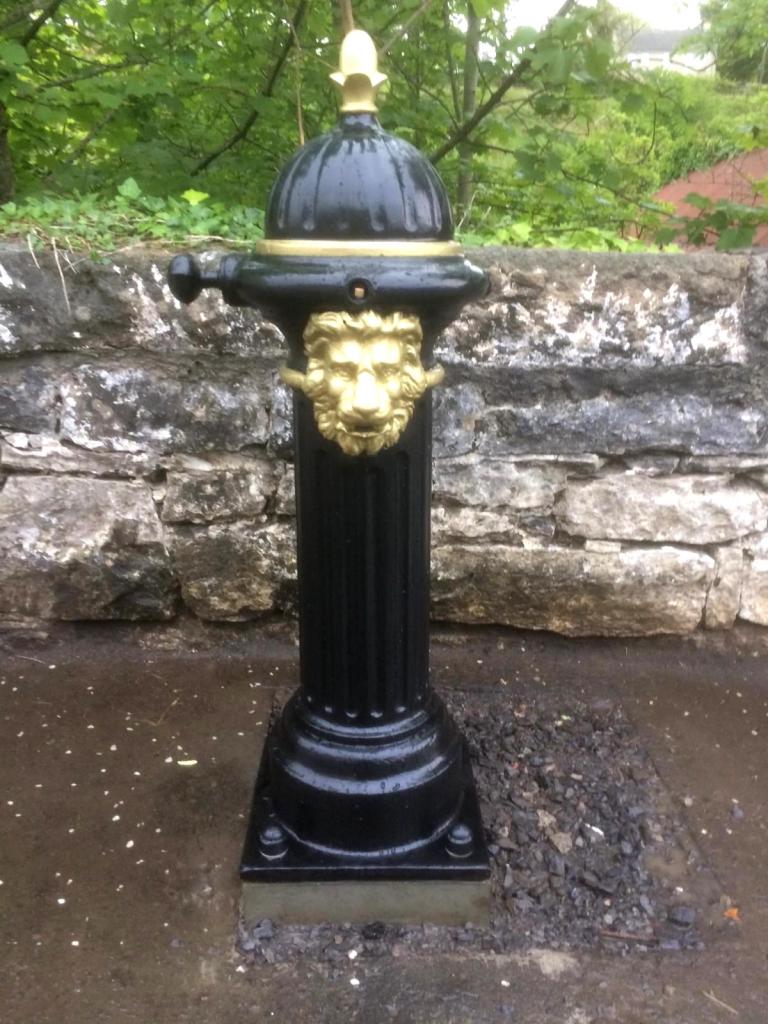Designed and manufactured by Glenfield & Kennedy Ltd. this late 19th century design was advertised as Kennedy’s patent, self-closing, anti-freezing pillar fountain. It consists of a fluted cast iron cylindrical column with moulded domed cap and small finial resembling a pineapple.
Water was drawn from a well by a wind pump and delivered by gravity from a reservoir. The water which was released by turning a decorative knob was located directly above a lion mascaron spout. It was captured in a tin cup suspended on a chain from the domed top. A small demi-lune trough at ground level captured overflow water for the use of dogs. Some models used a lever on the side to release the water and had an integral bucket platform located just above the base of the column.

Clifton-on-Teme, Hereford & Worcester, England. Manufacturer’s stamp on the base, Glenfield Coy Ltd.

Source: Scottish Ironwork Foundation. Photo by John P. Bolton
Shrewsbury, Shropshire, England. The instruction, Turn the Handle is redundant as the handle is missing. A legend beneath the lion mascaron states, Waste Not Want Not.

Ticknall, South Derbyshire, England. Located east of Hayes Farmhouse. It was erected 1914 at the behest of Sir Vauncey Harpur-Crewe of Calke Abbey. Bucket platform & lever are visible.

Washinborough, Lincoln, Lincolnshire, England. Located on the High Street this model contains an integral bucket platform. The manufacturer’s stamp is located beneath the lion mascaron, Glenfield & Kennedy Co. Kilmarnock.

Source: Flickr/Alan Saxman
Port Stanley, Falkland Islands. Manufacturer’s name is visible on the rear.

Source: Scottish Ironwork Foundation. Photo by R Williams
Kelso, Scottish Borders, Scotland. Currently located at Ednam House Hotel.

Source: Scottish Ironwork Foundation. Photo by John P. Bolton
Kilmun, Argyll & Bute, Scotland. Located within the church graveyard it is a unique example with the original cup and chain. A spigot projects from the lion’s mouth.

Source: Scottish Ironwork Foundation. Photo by John P. Bolton
Midlem, Scottish Borders, Scotland.

Source: Scottish Ironwork Foundation. Photo by John P. Bolton
Peebles, Scottish Borders, Scotland.

Source: Scottish Ironwork Foundation. Photo by John P. Bolton
Stirling, Scotland. Dog trough at base. The manufacturer’s name is located on the column within the trough.

Source: Scottish Ironwork Foundation. Photo by John P. Bolton
Stromness, Orkney Islands, Scotland. This model contains an integral bucket platform and a modern tap.

Source: Scottish Ironwork Foundation. Photo by John P. Bolton
Moniaive, Dumfries& Galloway, Scotland. Located at the base of steps leading to a gated entrance to Glencairn Church Graveyard. Painted white with a lever on the side.

Source: Scottish Ironwork Foundation. Photo by John P. Bolton
Killala, Co. Mayo, Ireland. Located at Seaview Terrace, the manufacturer’s stamp is visible beneath the lion mascaron, Glenfield & Kennedy Co. Kilmarnock

Source: Flickr/JohnnyG
Glossary:
- Demi-lune, half moon or crescent shape
- Finial, a sculptured ornament fixed to the top of a peak, arch, gable or similar structure
- Fluted, a long rounded groove
- Mascaron, a decorative element in the form of a sculpted face or head of a human being or an animal

























